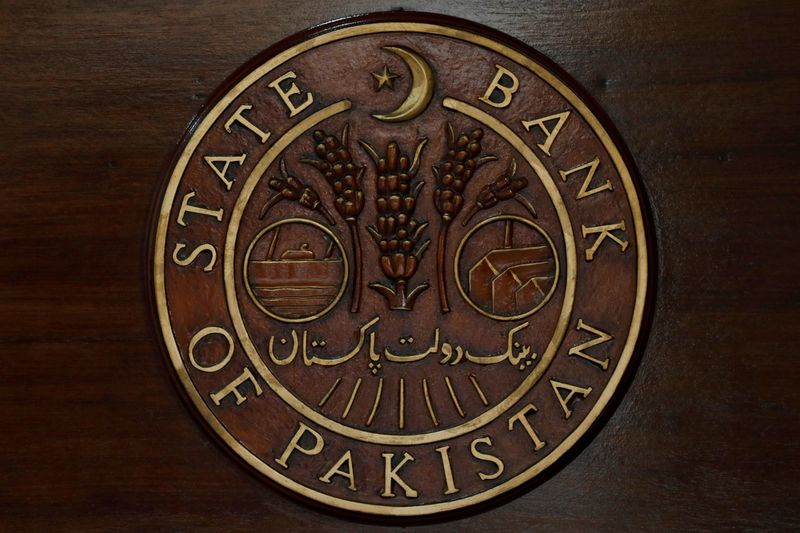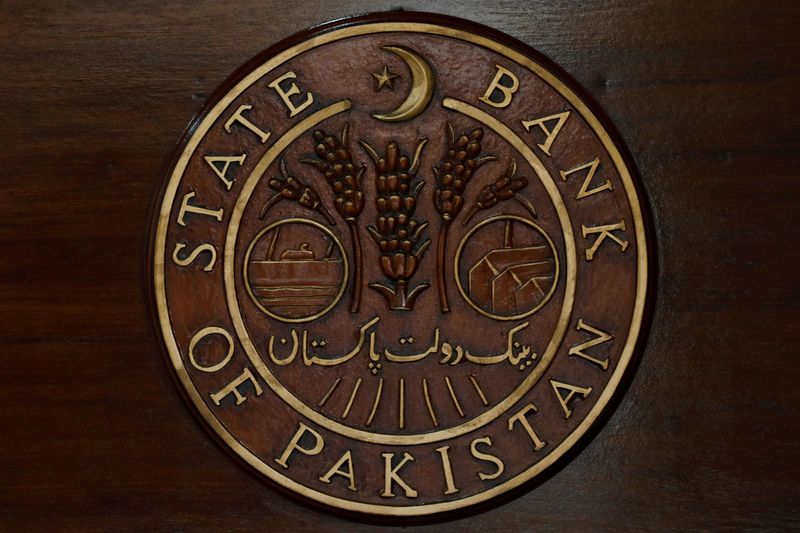Economy
Pakistan central bank keeps key rate steady, sees inflation easing gradually


© Reuters. FILE PHOTO: The logo of the State Bank of Pakistan (SBP) is pictured on a reception desk at the head office in Karachi, Pakistan July 16, 2019. REUTERS/Akhtar Soomro/File Photo
By Gibran Naiyyar Peshimam
KARACHI, Pakistan (Reuters) -Pakistan’s central bank kept its key rate unchanged at 22% on Monday after a scheduled meeting of its monetary policy committee, with inflation expected to decline gradually in coming months, the bank’s governor said.
Governor Jameel Ahmad told a press conference that the inflation outlook for the next fiscal year was between 20% and 22%, in line with government projections and that Pakistan’s deal with the International Monetary Fund (IMF) had not necessarily required a further rate hike.
“The IMF did not say anywhere that we have to increase rates,” Ahmad said. “They said the policy stance should be aggressive and we will go forward with an aggressive policy stance.”
The monetary policy committee meeting was the first since a new $3 billion bailout was approved by the IMF earlier this month for the ailing economy that had been teetering on the brink of a global debt default.
“The State Bank of Pakistan is comfortable that developments in the last few weeks will help stabilise the economy and, in spite of higher energy prices, inflation will come down,” said Mohammed Sohail, chief of Karachi-based investment house Topline Securities.
Ahmad said Pakistan was on “on course” to meet the medium-term inflation target of 5-7% and that the bank would ensure it complied with the IMF requirement of keeping the open market and interbank rates for the currency close to one another.
The IMF signalled following the bailout that the bank must continue with its monetary tightening cycle to tame inflation.
The State Bank of Pakistan (SBP) has raised its key policy rate by 12.25 percentage points since April 2022 to curb soaring inflation.
The rise in the consumer price index rise slowed in June from a record high of 38% year-on-year in May, but remained elevated at 29.4%. The CPI index decreased 0.3% in June from May.
The government projects inflation to average 21% for the current fiscal year that started on July 1. The IMF, however, forecasts inflation at 25.9% for the same period.
Pakistan’s central bank raised the key rate by 100 basis points to 22% in an off-cycle meeting in June, just weeks after having held rates at a scheduled meeting.
The bank noted on Monday that economic uncertainty had decreased since the last meeting, while near-term external sector challenges have been largely addressed and investor confidence had improved. It projected real GDP growth of between 2% and 3% for this fiscal year.
Pakistan’s government said the rates had been increased on the IMF’s demand in the run-up to the approval of the new bailout agreement.
Economy
Russian central bank says it needs months to make sure CPI falling before rate cuts -RBC


© Reuters. Russian Central Bank Governor Elvira Nabiullina attends a news conference in Moscow, Russia June 14, 2019. REUTERS/Shamil Zhumatov/File Photo
MOSCOW (Reuters) – Russia’s central bank will need two to three months to make sure that inflation is steadily declining before taking any decision on interest rate cuts, the bank’s governor Elvira Nabiullina told RBC media on Sunday.
The central bank raised its key interest rate by 100 basis points to 16% earlier in December, hiking for the fifth consecutive meeting in response to stubborn inflation, and suggested that its tightening cycle was nearly over.
Nabiullina said it was not yet clear when exactly the regulator would start cutting rates, however.
“We really need to make sure that inflation is steadily decreasing, that these are not one-off factors that can affect the rate of price growth in a particular month,” she said.
Nabiullina said the bank was taking into account a wide range of indicators but primarily those that “characterize the stability of inflation”.
“This will take two or three months or more – it depends on how much the wide range of indicators that characterize sustainable inflation declines,” she said.
The bank will next convene to set its benchmark rate on Feb. 16.
The governor also said the bank should have started monetary policy tightening earlier than in July, when it embarked on the rate-hiking cycle.
Economy
China identifies second set of projects in $140 billion spending plan


© Reuters. FILE PHOTO: Workers walk past an under-construction area with completed office towers in the background, in Shenzhen’s Qianhai new district, Guangdong province, China August 25, 2023. REUTERS/David Kirton/File Photo
SHANGHAI (Reuters) – China’s top planning body said on Saturday it had identified a second batch of public investment projects, including flood control and disaster relief programmes, under a bond issuance and investment plan announced in October to boost the economy.
With the latest tranche, China has now earmarked more than 800 billion yuan of its 1 trillion yuan ($140 billion) in additional government bond issuance in the fourth quarter, as it focuses on fiscal steps to shore up the flagging economy.
The National Development and Reform Commission (NDRC) said in a statement on Saturday it had identified 9,600 projects with planned investment of more than 560 billion yuan.
China’s economy, the world’s second largest, is struggling to regain its footing post-COVID-19 as policymakers grapple with tepid consumer demand, weak exports, falling foreign investment and a deepening real estate crisis.
The 1 trillion yuan in additional bond issuance will widen China’s 2023 budget deficit ratio to around 3.8 percent from 3 percent, the state-run Xinhua news agency has said.
“Construction of the projects will improve China’s flood control system, emergency response mechanism and disaster relief capabilities, and better protect people’s lives and property, so it is very significant,” the NDRC said.
The agency said it will coordinate with other government bodies to make sure that funds are allocated speedily for investment and that high standards of quality are maintained in project construction.
($1 = 7.1315 renminbi)
Economy
Russian central bank says it needs months to make sure CPI falling before rate cuts -RBC


© Reuters. Russian Central Bank Governor Elvira Nabiullina attends a news conference in Moscow, Russia June 14, 2019. REUTERS/Shamil Zhumatov/File Photo
MOSCOW (Reuters) – Russia’s central bank will need two to three months to make sure that inflation is steadily declining before taking any decision on interest rate cuts, the bank’s governor Elvira Nabiullina told RBC media on Sunday.
The central bank raised its key interest rate by 100 basis points to 16% earlier in December, hiking for the fifth consecutive meeting in response to stubborn inflation, and suggested that its tightening cycle was nearly over.
Nabiullina said it was not yet clear when exactly the regulator would start cutting rates, however.
“We really need to make sure that inflation is steadily decreasing, that these are not one-off factors that can affect the rate of price growth in a particular month,” she said.
Nabiullina said the bank was taking into account a wide range of indicators but primarily those that “characterize the stability of inflation”.
“This will take two or three months or more – it depends on how much the wide range of indicators that characterize sustainable inflation declines,” she said.
The bank will next convene to set its benchmark rate on Feb. 16.
The governor also said the bank should have started monetary policy tightening earlier than in July, when it embarked on the rate-hiking cycle.

 Forex2 years ago
Forex2 years agoForex Today: the dollar is gaining strength amid gloomy sentiment at the start of the Fed’s week

 Forex2 years ago
Forex2 years agoHow is the Australian dollar doing today?

 Forex1 year ago
Forex1 year agoUnbiased review of Pocket Option broker

 Forex2 years ago
Forex2 years agoDollar to pound sterling exchange rate today: Pound plummeted to its lowest since 1985

 Cryptocurrency2 years ago
Cryptocurrency2 years agoWhat happened in the crypto market – current events today

 World2 years ago
World2 years agoWhy are modern video games an art form?

 Stock Markets2 years ago
Stock Markets2 years agoMorgan Stanley: bear market rally to continue

 Economy2 years ago
Economy2 years agoCrude oil tankers double in price due to EU anti-Russian sanctions

































